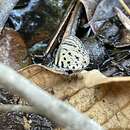en
names in breadcrumbs


Azanus mirza, the pale babul blue or mirza blue,[2] is a butterfly of the family Lycaenidae. It is found in the Afrotropical realm.
The wingspan is 20–25 millimetres (0.79–0.98 in) in males and 21–25 millimetres (0.83–0.98 in) in females. Its flight period is year-round but mainly between September and March.[2]
The larvae feed on Acacia and Allophylus species.[2]
![]() Media related to Azanus mirza at Wikimedia Commons
Media related to Azanus mirza at Wikimedia Commons
Azanus mirza, the pale babul blue or mirza blue, is a butterfly of the family Lycaenidae. It is found in the Afrotropical realm.
The wingspan is 20–25 millimetres (0.79–0.98 in) in males and 21–25 millimetres (0.83–0.98 in) in females. Its flight period is year-round but mainly between September and March.
The larvae feed on Acacia and Allophylus species.